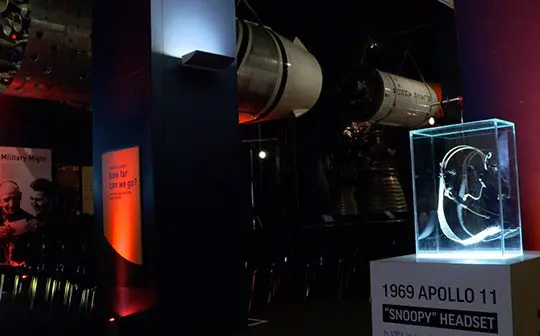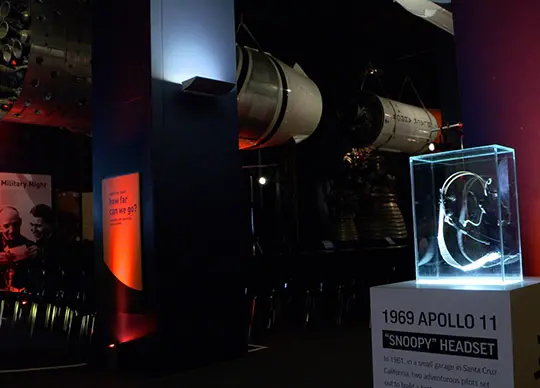
MS50 Plantronics headset
The Communications Carrier Assembly, or CCA, is a lightweight system worn under the helmet by the crew. It includes an electronic audio system (a Plantronics headset) with ear cups specifically molded to the astronauts’ ears, and a cloth cap to hold and hold the set on the astronaut’s head. The Plantronics headset is an improved version in only 11 days of the Plantronics MS50, already well known to American aviation since 1962.
It features two earphones and two flexible boom-mounted microphones to provide operational redundancy: the loss of a microphone or earpiece does not affect the mission.
The CCA also includes head protection padding, a large knit area on the top and back of the head to minimize heat accumulation and improve comfort. Moisture absorbing padding is provided to prevent perspiration from entering the eyes.

The “Snoopy Cap”
The “Snoopy Cap” is the nickname given to the cap incorporating the communication system (CCA), because of its resemblance to the famous character of the comic book, Peanuts, that astronauts wear for almost the entire flight time. Unsatisfied with the helmet he wore during training for the Apollo 8 mission, astronaut James Lovell asked his colleague to improve it: he then copied the leather caps of the Royal Air Force, much more practical, replacing leather, not fabric. This is how the famous Snoopy Cap was born!
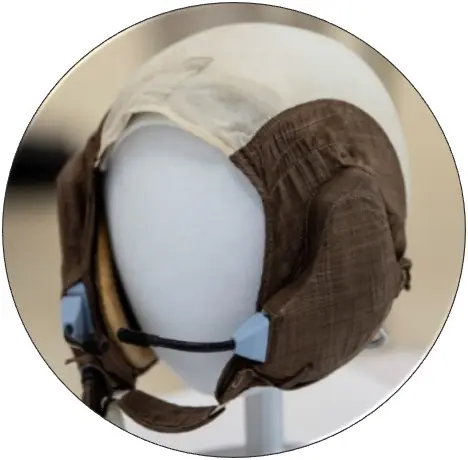
Saving Neil’s suit!
 In 2015, a call for donations was launched to raise the funds needed to preserve the suit worn by Neil Armstrong during the moon landing, a true symbol of the conquest of space. Very deteriorated, the Washington Air and Space Museum (which also has the Apollo 11 capsule) had not exposed the combination to the public since 2006.
In 2015, a call for donations was launched to raise the funds needed to preserve the suit worn by Neil Armstrong during the moon landing, a true symbol of the conquest of space. Very deteriorated, the Washington Air and Space Museum (which also has the Apollo 11 capsule) had not exposed the combination to the public since 2006.
A call for donations named “Reboot the Suit” was then made on the crowdfunding site Kickstarter: in one month, 9,477 netizens donated $ 642,028. Nevertheless, some parts of the suit, such as gloves, inevitably deteriorate.
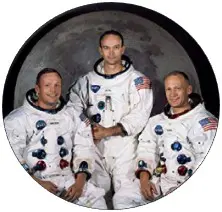 Buzz Aldrin, the Unsung Hero
Buzz Aldrin, the Unsung Hero
If Neil Armstrong is in the limelight, a second astronaut who also walked the moon was one of the protagonists of the conquest of the moon. Edwin Eugene Aldrin Junior, better known as Buzz Aldrin, was then a pilot of the mission and logically the first to set foot on the moon. So why Neil, not Buzz? Christopher Kraft, director of flight operations at NASA for the Apollo missions, reveals in his autobiography that Neil’s personality, “calm, quiet, with total confidence,” played a lot. And it was precisely because he did not ask that Armstrong was chosen to mark the story.
Another hypothesis emphasizes that NASA wanted a civilian to take the first steps on the moon to prevent this mission from being equated with a military conquest. But Neil had joined NASA as a civilian, unlike Aldrin who had remained under military status.
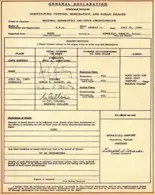 Something to Report?
Something to Report?
Upon their return to Earth, astronauts Armstrong, Aldrin and Collins were subjected to customs control, just like any traveler entering the United States.
Passport, flight number (Apollo 11), itinerary (Moon / Honolulu, Hawaii), everything was detailed, up to the contents of the “baggage”: 22 kilos of dust and lunar rocks!
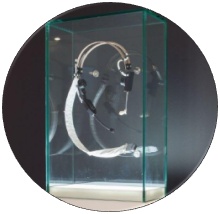 And it is with a touch of humor that they indicated, in the box “possibility of bringing infectious agents likely to cause an epidemic”: to be determined!
And it is with a touch of humor that they indicated, in the box “possibility of bringing infectious agents likely to cause an epidemic”: to be determined!
Ironically, the three astronauts were quarantined for about three weeks when they returned, fearing that they had contracted a virus

